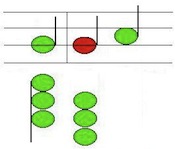
HARMONIC EXPANSIONS
CHAPTER 2: NONHARMONIC TONES
2.10 Retardations
 |
 |
 |

Wofgang Amadeus Mozart |
Harmonic expectations, 1: Too few notes to define a triad. In the last measure of the above beginner's minuet, Mozart wrote a B which strongly clashes with the C in the left hand. With such sparse writing how can this dissonance be analyzed in terms of nonharmonic tones? Despite the lack of obvious chords, dominant and tonic harmonies are implied immediately before and during the dissonant seventh (see the Roman numerals below the staffs). This interval's low note--a tonic C--its position at the first beat of the last measure, and the notes which immediately precede it in the bass--scale degree 5--all imply the expected V - I harmonies which conclude the fundamental harmonic progression.
In this context:
- the E and C in the top staff of the next-to-the-last measure are accented passing tones (PT),
- the final note of this measure, B, is a chord tone, and
- the first note of the last measure, also B, is a nonharmonic tone. This nonharmonic tone is called a retardation (RE).
| In general a retardation is an accented nonharmonic tone which is prepared by the same note and then resolves by rising to a chord tone by step. See the graphic on the right. Retardations are "upside-down" suspensions because the resolution goes up instead of down. As in the example above retardations often rise from the leading tone to tonic at the end of a phrase. |

|
|
In the video to the left a retardation expands the final tonic of a fundamental harmonic progression . It delays last note of the soprano line, scale degrees 1 - 7 - 1. |
 |
 |
 |
 |
Comments? Click here. |



